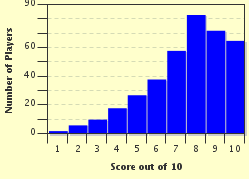Quiz Answer Key and Fun Facts
1. The ruins of Battle Abbey stand facing the field where the battle that it was erected to commemorate occurred. Many historians believe that this was the singular most important battle in English history. If I say 1066, what place jumps to mind?
2. This monument stands to commemorate a Scottish hero who has been immortalised (although not always accurately) in film. The battle was Stirling Bridge and the year was 1297. Who does this monument honour?
3. This city on the Baltic Sea is currently part of Poland. During its history it frequently changed hands between Poland and Germany and at two different times was actually a free city. It has been much besieged in its history and suffered heavily during WWII. Called Danzig by the Germans, by what name is it known in Poland?
4. This innocent looking moor in the Scottish Highlands was the site of the final and decisive battle between the English and the Scots in the Jacobite Uprising of 1745. Where can this blood soaked field be found?
5. This picture of the Plains of Abraham, located just outside the walled city of Quebec, was taken in 1908. The Battle of the Plains of Abraham took place on September 13, 1759. It was a decisive battle in the Seven Years War, also known as the French and Indian War.
What were the names of the two generals, both of whom received mortal wounds in the battle, who faced off that day?
6. Inspired by Hans Christian Andersen's "The Little Mermaid", this bronze statue by Edvard Eriksen was unveiled in 1913. This makes her over 106 years too young to have witnessed the British bombardment (during the Napoleonic Wars) in the city which she adorns. What city is this?
7. Fort Erie, the reconstruction of which is pictured here, was occupied by hostile troops during the War of 1812. Who were the combatants in the War of 1812?
8. This cemetery in Ypres, Belgium holds only a few of the soldiers killed in the area during WWI. Strategically located, Ypres was the site of three major battles during the war. The third battle, from July 21st to November 6th 1917 was the most horrific. Immortalized in song by Chris de Burgh and named after the ridge recaptured from the Germans, what was the name of this battle?
9. During WWII this Russian city, located on the Baltic Sea, was the site of one of the longest and most devastating sieges in history. Over time the city has been called by three different names. What was it called at the time of the siege?
10. This windy little island is part of a British territory that lies off the coast of South America. On April 2nd, 1982 it was invaded by Argentina in an attempt to claim the sovereignty Argentina feels it is entitled to. Which British royal was co-pilot of a helicopter during the campaign?
Source: Author
skunkee
This quiz was reviewed by FunTrivia editor
bloomsby before going online.
Any errors found in FunTrivia content are routinely corrected through our feedback system.

